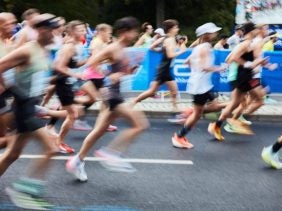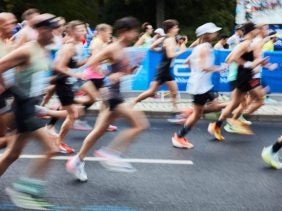Here’s Exactly How to Breathe When Running
 ©The Good Brigade
©The Good Brigade
With proper breathing technique for running, you can prevent side stitches and shortness of breath, so your run is not only faster but also more fun. Get in the fast lane and stay there with our Energy Aminos. The combination of caffeine, vitamins, and amino acids is perfect for kickstarting your workout.
Ever feel like you’re gasping for breath or have painful side stitches and dizziness spells when you run? That’s a clear sign that you need to work on your breathing technique! With all the training plans, equipment, nutrition, and regeneration involved in running, it’s easy to forget about breathing. After all, it happens all by itself, so you can’t go wrong, right? Wrong! Even with something as simple as breathing, there are some common mistakes that most of us make.
Sure, some runners intuitively breathe in the way that works best for them. But even if you belong to this lucky group, you can still learn to breathe even more effectively with targeted breathing exercises. They’ll optimize your oxygen supply and, in the long run, your lung volume itself, so you can fully enjoy the mental benefits of running, and maybe even trim down the last few seconds to your new best time.
A good breathing technique for running can also help you in your everyday life. Consciously controlling your breath and breathing deeply can calm your mind and make feelings of stress go away. Try it: put one hand on your belly and breathe deeply and slowly into your hand 5 times. How do you feel now? If you want more of that stress reduction in your life, check out these 9 tips for more calm!
Why Is Breathing Technique Important for Running?
Anyone who practices yoga already knows that breathing is an important link between body and mind and can be improved with regular training. If you breathe efficiently, you’ll not only perform better, but also have more fun running, so it’s both your body and mind that benefit from good, deep breathing.
The most important effects of proper breathing while running are
- optimal oxygen supply
- better blood circulation
- in the long term: increase in lung volume
- better physical performance
- more mental relaxation and better focus
- less tension
Can you breathe wrong?
Yes. On a purely physiological level, the best breathing for running maximizes your oxygen intake capacity while exhaling the maximum amount of carbon dioxide. Chest breathing and inhaling through your nose aren’t going to get you there.
In addition, shallow chest breathing, or the even-more-ineffective collarbone breathing, tends to make you hunch your shoulders and tense up, which can lead to neck and shoulder pain while running and in everyday life. Rapid short breathing also increases feelings of stress.

Is it Better to Breathe Through Your Nose or Mouth?
It all depends on how fast you’re running. At a slower pace, many runners breathe in through their nose and out through their mouth automatically. But once you go faster, you won’t get enough oxygen with nasal breathing.
That’s why it’s better to go for a combination of mouth and nose breathing, so breathing in through both your mouth and nose at the same time.
Inhaling through your nose can be a good idea when it’s cold outside. When you breathe through your nose, the air travels a longer distance to reach your lungs than when you breathe through your mouth. That also means the air warms up more and feels better in your lungs. But because of the lower total volume of oxygen, you may have to run a little slower.
Is the winter too cold for you to breathe enough? Try putting a thick scarf over your nose and mouth for when you breathe in. Maybe run a little slower than usual. When the scarf gets too damp, just flip it over.
Breathing for Running: All about your abs
The simple answer to oxygen optimization is abdominal breathing! It’s the only way to make full use of the entire volume of your lungs and give your muscles a full dose of oxygen. Thanks to the deeper inhalation, the fresh air stays deeper in your lungs for longer and allows you to take in more oxygen overall. The breathing rate of abdominal breathing, also known as diaphragmatic breathing, is lower than that of chest breathing. How can you tell if it’s abdominal breathing? The abdominal wall will rise and fall significantly as you inhale and exhale.
Chest breathing causes side stitches and shortness of breath in many runners. You can tell that you’re breathing into your chest instead of your abdomen when your breaths tend to be short, and you have to take frequent short breaths, like panting.
If you’re chest breathing while running, you’re only using the upper part of your lungs instead of their full capacity. As a result, not much oxygen gets to your body, and you’ll get tired more quickly, feel weaker, and may even get dizzy. On top of that, a lack of oxygen leads to tension in your diaphragm, which results in painful side stitches.
Read more: Click here for our tips on how to recognize, prevent, and combat side stitches while running.
Running Breath Frequency: The pace sets the pace. Right?
Opinions are split on this question. Just as many people support a fixed breathing rhythm when running as oppose it. Proponents recommend matching your breathing rate to your stride rate to improve oxygen uptake and avoid side stitches.
This works primarily by focusing on your inhalation, which looks like this:
- 3:3 rhythm for easy runs: you take 3 steps for each inhalation and exhalation.
- 2:2 rhythm for fast runs: 2 steps for each inhalation and exhalation.
- 2:1 rhythm for competitions and sprints: 2 steps for each inhalation and one step for each exhalation.
If you don’t have problems with side stitches or shortness of breath but are actually getting along relatively well, it’s not absolutely necessary to adjust your breathing rhythm to the stride rate. Many runners get out of sync when they focus on it and find their running gets more strenuous and less fluid.
Our tip: Try it a few times. If nothing else, by consciously synchronizing your breathing and stride rate, you’ll definitely train your coordination. If it doesn’t work for you after a few times, stick with your tried and true methods.
Breathing for Running: Train your breath
Essentially, you need to breathe through your mouth and nose at the same time while running and, above all, breathe deeply. This kind of breathing can be trained best with exercises both before and during your run. There are tons of breathing exercises and strategies out there. We like the following because they are simple and can be used by any healthy athlete.
- Stand or sit up straight. Relax your shoulders and chest. Place one hand on your upper abdomen. Close your eyes if you like. Breathe in and out deeply through your mouth and nose, and feel your chest rise and fall. This is diaphragmatic breathing.
- Same set-up as exercise 1. Now try to lengthen your inhalation by breathing in for as long as you can and exhaling completely. Stay relaxed but still push yourself to the limit of your lung capacity.
- Hold your left nostril closed and inhale through your right nostril. Then hold your right nostril closed and exhale through your left, before breathing back in on the left, out on the right, in on the right, and so on. This traditional yoga breathing exercise also optimizes oxygen intake through your nose.
Conclusion
- The correct breathing technique while jogging allows you to take advantage of your body’s maximum possible oxygen uptake and carbon dioxide exhalation. This has various positive effects that result in improved performance.
- Breathe deeply through your mouth and nose when running.
- Proper breathing for running can be trained.
More healthy living tips from foodspring:
- 6 Genius Ways to Have a Fitter Brain
- Breathing While Lifting: The most effective breathing techniques
- Basic Endurance: How do you keep the pace for longer?
- What to Eat Before a Workout – Our Rules for 3 Goals
- Harder, Better, Faster, Stronger: Body conditioning the right way
Sources for this article
We at foodspring use only high-quality sources, including peer-reviewed studies, to support the facts within our articles. Read our editorial policy to learn more about how we fact-check and keep our content accurate, reliable, and trustworthy.

































